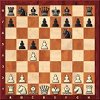


Dennis Monokroussos writes:
With the Hungarian/American grandmaster Pal Benko turning 80 earlier this week, it seems like a good time to celebrate his chess with a look at his best-known contribution to the chess world, the eponymous Benko Gambit. Benko, a two-time world championship Candidate, did not event the gambit (known as the "Volga Gambit" in some parts of the world), but he was the first strong grandmaster to use it on a regular basis. It's because of his efforts, starting in the late 60s, that the opening became a popular opening among professionals and amateurs alike.
|
The Gambit is a remarkable weapon. Black gives up a pawn on move 3, and in return gains neither time, attacking chances against White's king or even any initiative to speak of. Stranger still, Black is often delighted to exchange piece after piece – just the opposite of what we'd expect from a gambit. What he does enjoy is very long term pressure against White's queenside along the a- and b-files (at least in classic lines where White accepts the gambit), the kind of pressure that can pay off 15, 20, even 30 or more moves down the road. It's an excellent fighting weapon, especially against those players who use 1.d4 in hopes of reaching a safe, quiet position where only two results (a White win or a draw) are possible, as there is no way for White to dry the game up, even if he's well-prepared.

Pal Benko (red jacket) with friends, celebrating his 80th birthday (photo:
Susan
Polgar chess blog)
Now that I've whetted your appetite, I hope you'll join me tonight – Wednesday night – at 9 p.m. ET, as we see how the master and founding father of this system handled it in his own games. We'll see some of his ideas about the opening per se, but more importantly, we'll see how the Benko Gambit plays itself out in the middlegame and ending. This will give us a template, enabling us to see some of the thematic ideas we can use to win our own games. Pure practicality!
(If your only reservation is cost, then fear not: it's free. Not sure how to watch? Again, it's no problem: click here to read full directions. See you then!)
Dennis Monokroussos' Radio ChessBase lectures begin on Wednesdays at 9 p.m. EST, which translates to 02:00h GMT, 03:00 Paris/Berlin, 13:00h Sydney (on Thursday). Other time zones can be found at the bottom of this page. You can use Fritz or any Fritz-compatible program (Shredder, Junior, Tiger, Hiarcs) to follow the lectures, or download a free trial client. |
You can find the exact times for different locations in the world at World Time and Date. Exact times for most larger cities are here. And you can watch older lectures by Dennis Monokroussos offline in the Chess Media System room of Playchess:

Enter the above archive room and click on "Games" to see the lectures. The lectures, which can go for an hour or more, will cost you between one and two ducats. That is the equivalent of 10-20 Euro cents (14-28 US cents).
 Monokroussos in Mexico: World Championship 2007 |
Dennis Monokroussos is 41, lives in South Bend, IN, where he teaches chess and occasionally works as an adjunct professor of philosophy at the University of Notre Dame and Indiana University-South Bend.
At one time he was one of the strongest juniors in the U.S. and has reached a peak rating of 2434 USCF, but several long breaks from tournament play have made him rusty. He is now resuming tournament chess in earnest, hoping to reach new heights.
Dennis has been working as a chess teacher for ten years now, giving lessons to adults and kids both in person and on the internet, worked for a number of years for New York’s Chess In The Schools program, where he was one of the coaches of the 1997-8 US K-8 championship team from the Bronx, and was very active in working with many of CITS’s most talented juniors.
When Dennis Monokroussos presents a game, there are usually two main areas of focus: the opening-to-middlegame transition and the key moments of the middlegame (or endgame, when applicable). With respect to the latter, he attempts to present some serious analysis culled from his best sources (both text and database), which he has checked with his own efforts and then double-checked with his chess software.